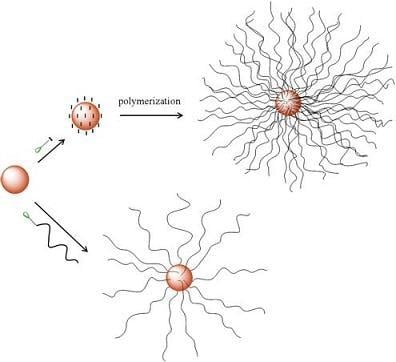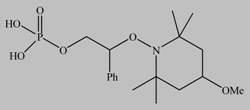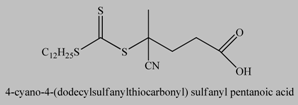End-Grafted Polymer Chains onto Inorganic Nano-Objects
Abstract
:1. Introduction
2. Results and Discussion
2.1. Polymer-grafted silica nanoparticles
2.1.1. “Grafting to” method

2.1.2. “Grafting from” approach
2.1.2.1. “Hairy” homopolymer and block copolymer silica particles

| No | Initiator | Ref. |
|---|---|---|
| 1 | 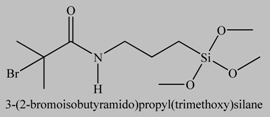 | [49,53,54,55,56,57,58,59,60] |
| 2 |  | [61,62] |
| 3 | 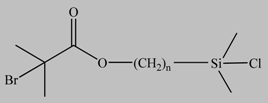 | [63,64,65,66] |
| 4 |  | [40,67] |
| 5 | 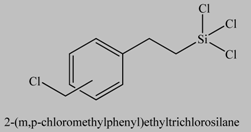 | [68,69,70,71] |
| 6 |  | [72] |
| 7 | 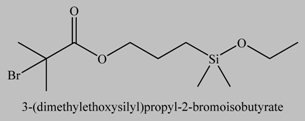 | [45,46] |
| No | RAFT agent | Polymer | Ref. |
|---|---|---|---|
| 1 |  | PnBA, PS-b-PnBA | [88] |
| 2 |  | PMMA | [90] |
| 3 |  | PMA, PnBA, PMMA, PS, PNIPAM, PDMA | [89] |
| 4 |  | PMA, PnBA, PMMA, PS, PNIPAM, PDMA | [89] |
2.1.2.2. Grafted comb and branched polymer architectures
| No | Inimer | Ref. |
|---|---|---|
| 1 |  | [66] |
| 2 |  | [56] |
2.1.2.3. Responsive nanohybrids
pH- and temperature-sensitive core-shell systems
Photo-responsive hybrids
Hybrids with gating properties
Pickering emulsions and Janus nanohybrids
2.2. Polymer-grafted Silsequioxane nanoparticles
2.2.1. Star-shaped hybrids
2.2.2. Tadpole-shaped hybrids
2.2.3. Telechelic and hemitelechelic POSS-containing hybrids
2.3. Polymer-grafted metal-oxide semiconducting nanoparticles
2.3.1. Polymer-grafted TiO2 nanoparticles

2.3.2. Polymer-grafted ZnO nanoparticles
2.4. Polymer-grafted magnetic nanoparticles
| No | Initiators | Ref. |
|---|---|---|
| 1 |  | [185] |
| 2 |  | [183] |
| 3 | 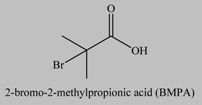 | [180,182,186,187,188,189] |
| 4 |  | [184] |
| 5 | 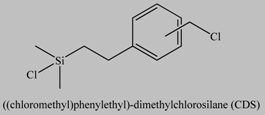 | [177] |
2.5. Polymer-grafted metal nanoparticles
2.5.1. Hybrid gold nanocolloids
2.5.1.1. “Grafting to” approach
2.5.1.2. “Grafting from” method
| No | Initiator | Polymer | Ref. |
|---|---|---|---|
| 1 |  | P4VP, PMMA, P(MeO-PEGMA)-b-PNIPAM, PNIPAM, PDMAEMA-co-PDEAEMA-co-P(PEGMA) | [228,229,230,231,232,233,234,236] |
| 2 |  | PMMA, PnBA, PtBA | [237,238,239] |
| 3 |  | PDMAEMA | [234] |
2.5.2. Polymer-coated platinum nanoparticles
2.6. Polymer-grafted quantum dots
2.6.1. “Grafting to” method

2.6.2. “Grafting from” approach
3. Conclusions and Perspectives
Acknowledgements
Abbreviations
| AGET | activators generated by electron transfer |
| ATRP | atom-transfer radical polymerization |
| BPEA | 2-(2-bromopropionyloxy)ethyl acrylate |
| CMS | p-chloromethyl styrene |
| CRP | controlled radical polymerization |
| CT | computed tomography |
| FRET | fluorescence resonance energy transfer |
| LbL | layer-by-layer |
| LCST | lower critical solution temperature |
| MC | merocyanine |
| MeO-PEGMA | methoxy-poly(ethylene glycol) methacrylate |
| NMP | nitroxide-mediated radical polymerization |
| P(MeO-PEGMA)-b-PNIPAM | poly(methoxy-poly(ethylene glycol) methacrylate)-b-poly(N-isopropylacrylamide) |
| P2VP | poly(2-vinyl pyridine) |
| P3HT | poly(3-hexylthiophene) |
| P3VP | poly(3-vinyl pyridine) |
| P4VP | poly(4-vinyl pyridine) |
| PAA | poly(acrylic acid) |
| PAN | polyacrylonitrile |
| PB-PEG | polybutadiene-poly(ethylene glycol) |
| PCEMA | poly(2-(carbazol-9-yl)ethyl methacrylate) |
| PCYPAAM | poly(N-cyclopropylacrylamide) |
| PDEAEMA | poly(2-diethylamino)ethyl methacrylate) |
| PDMA | poly(N,N-dimethylacrylamide) |
| PDMAEMA | poly(2-dimethylamino)ethyl methacrylate) |
| PEO | poly(ethylene oxide) |
| PHEA | poly(hydroxyethyl acrylate) |
| PHEMA | poly(2-hydroxyethyl mehacrylate) |
| PMA | poly(methyl acrylate) |
| PMMA | poly(methyl methacrylate) |
| PnBA | poly(n-butyl acrylate) |
| PnBMA | poly(butyl methacrylate) |
| PNIPAM | poly(N-isopropylacrylamide) |
| POEMA | poly(oxyethylene methacrylate) |
| POSS | polyhedral oligomeric silsesquioxanes |
| PS | Polystyrene |
| PS-b-PnBA | polystyrene-b-poly(n-butyl acrylate) |
| PSP-co-PMMA | Poly(spirobenzopyran)-co-poly(methyl methacrylate) |
| PSS | poly(styrene sulfonic acid) |
| PtBA | poly(t-buyl acrylate) |
| RAFT | reversible addition-fragmentation chain transfer |
| ROMP | ring-opening metathesis polymerization |
| ROP | ring-opening polymerization |
| SAMs | self-assembled monolayers |
| SCVP | self-condensing vinyl polymerization |
| SFRP | stable free radical polymerization |
| si-ATRP | surface-initiated atom-transfer radical polymerization |
| SP | spiropyran |
| TOPO | trioctylphosphine oxide |
| UCST | upper critical solution temperature |
References and Notes
- Caruso, F. Nanoengineering of particle surfaces. Adv. Mater. 2001, 13, 11–22. [Google Scholar] [CrossRef]
- Golden, J.H.; Deng, H.; DiSalvo, F.J.; Fréchet, J.M.J.; Thompson, P.M. Monodisperse metal clusters 10 angstroms in diameter in a polymeric host: The "monomer as solvent" approach. Science 1995, 268, 1463–1466. [Google Scholar] [CrossRef] [PubMed]
- Zhou, Q.; Wang, S.; Fan, X.; Advincula, R.; Mays, J. Living anionic surface-initiated polymerization (lasip) of a polymer on silica nanoparticles. Langmuir 2002, 18, 3324–3331. [Google Scholar] [CrossRef]
- Pyun, J.; Kowalewski, T.; Matyjaszewski, K. Synthesis of polymer brushes using atom transfer radical polymerization. Macromol. Rapid Commun. 2003, 24, 1043–1059. [Google Scholar] [CrossRef]
- Mansky, P.; Liu, Y.; Huang, E.; Russell, T.P.; Hawker, C. Controlling polymer-surface interactions with random copolymer brushes. Science 1997, 275, 1458–1460. [Google Scholar] [CrossRef]
- Spange, S. Silica surface modification by cationic polymerization and carbenium intermediates. Prog. Polym. Sci. 2000, 25, 781–849. [Google Scholar] [CrossRef]
- Eismann, U.; Spange, S. Cationic initiation of vinyl ether polymerization induced by (4-R1C6H4)(4-R2C6H4)R3CX in conjunction with silica: Producing highly head group functionalized polymers. Macromolecules 1997, 30, 3439–3446. [Google Scholar] [CrossRef]
- Spange, S.; Höhne, S.; Francke, V.; Günther, H. The cationic polymerization of 2-vinylfuran on the surface of silica particles−An NMR spectroscopic study. Macromol. Chem. Phys. 1999, 200, 1054–1061. [Google Scholar] [CrossRef]
- Hohne, S.; Spange, S. Surface functionalization of silica with 2-vinylfuran by cationic polymerization. Macromol. Chem. Phys. 2003, 204, 841–849. [Google Scholar] [CrossRef]
- Zirbs, R.; Binder, W.; Gahleitner, M.; Machl, D. "Grafting from"-living cationic polymerization of poly(isobutylene) from silica-nanoparticle surfaces. Macromol. Symp. 2007, 254, 93–96. [Google Scholar] [CrossRef]
- Carrot, G.; Rutot-Houze, D.; Pottier, A.; Degee, P.; Hilborn, J.; Dubois, P. Surface-initiated ring-opening polymerization: A versatile method for nanoparticle ordering. Macromolecules 2002, 35, 8400–8404. [Google Scholar] [CrossRef]
- Yoon, K.R.; Lee, Y.W.; Lee, J.K.; Choi, I.S. Silica/poly(1,5-dioxepan-2-one) hybrid nanoparticles by "direct" surface-initiated polymerization. Macromol. Rapid Commun. 2004, 25, 1510–1513. [Google Scholar] [CrossRef]
- Joubert, M.; Delaite, C.; Bourgeat-Lami, E.; Dumas, P. Hairy PEO-silica nanoparticles through surface-initiated polymerization of ethylene oxide. Macromol. Rapid Commun. 2005, 26, 602–607. [Google Scholar] [CrossRef]
- Joubert, M.; Delaite, C.; Lami, E.B.; Dumas, P. Synthesis of poly(ε-caprolactone)-silica nanocomposites: From hairy colloids to core-shell nanoparticles. New J. Chem. 2005, 29, 1601–1609. [Google Scholar] [CrossRef]
- Joubert, M.; Delaite, C.; Bourgeat-Lami, E.; Dumas, P. Ring-Opening polymerization of ε-caprolactone and L-lactide from silica nanoparticles surface. J. Polym. Sci. A 2004, 42, 1976–1984. [Google Scholar] [CrossRef]
- Mingotaud, A.F.; Reculusa, S.; Mingotaud, C.; Keller, P.; Sykes, C.; Duguet, E.; Ravaine, S. Ring-opening metathesis polymerization on well defined silica nanoparticles leading to hybrid core-shell particles. J. Mater. Chem. 2003, 13, 1920–1925. [Google Scholar] [CrossRef]
- Jordi, M.A.; Seery, T.A.P. Quantitative determination of the chemical composition of silica-poly(norbornene) nanocomposites. J. Am. Chem. Soc. 2005, 127, 4416–4422. [Google Scholar] [CrossRef] [PubMed]
- Milner, S.T. Polymer brushes. Science 1991, 251, 905–914. [Google Scholar] [CrossRef] [PubMed]
- Percec, V.; Popov, A.V.; Ramirez-Castillo, E.; Monteiro, M.; Barboiu, B.; Weichold, O.; Asandei, A.D.; Mitchell, C.M. Aqueous room temperature metal-catalyzed living radical polymerization of vinyl chloride. J. Am. Chem. Soc. 2002, 124, 4940–4941. [Google Scholar] [CrossRef] [PubMed]
- Matyjaszewski, K.; Tsarevsky, N.V. Nanostructured functional materials prepared by atom transfer radical polymerization. Nat. Chem. 2009, 1, 276–288. [Google Scholar] [CrossRef] [PubMed]
- Stober, W.; Fink, A.; Bohn, E. Controlled growth of monodisperse silica spheres in the micron size range. J. Colloid Interface Sci. 1968, 26, 62–69. [Google Scholar] [CrossRef]
- Ranjan, R.; Brittain, W.J. Combination of living radical polymerization and click chemistry for surface modification. Macromolecules 2007, 40, 6217–6223. [Google Scholar] [CrossRef]
- Huang, L.; Dolai, S.; Raja, K.; Kruk, M. "Click" grafting of high loading of polymers and monosaccharides on surface of ordered mesoporous silica. Langmuir 2009. [Google Scholar] [CrossRef]
- Huang, Y.; Liu, Q.; Zhou, X.; Perrier, S.B.; Zhao, Y. Synthesis of silica particles grafted with well-defined living polymeric chains by combination of RAFT polymerization and coupling reaction. Macromolecules 2009, 42, 5509–5517. [Google Scholar] [CrossRef]
- De Las Heras Alarcόn, C.; Pennadam, S.; Alexander, C. Stimuli responsive polymers for biomedical applications. Chem. Soc. Rev. 2005, 34, 276–285. [Google Scholar] [CrossRef] [PubMed]
- Schild, H.G. Poly(N-isopropylacrylamide): Experiment, theory and application. Prog. Polym. Sci. 1992, 17, 163–249. [Google Scholar] [CrossRef]
- Huang, C.-J.; Chang, F.-C. Using click chemistry to fabricate ultrathin thermoresponsive microcapsules through direct covalent layer-by-layer assembly. Macromolecules 2009, 42, 5155–5166. [Google Scholar] [CrossRef]
- von Werne, T.; Patten, T.E. Preparation of structurally well-defined polymer-nanoparticle hybrids with controlled/living radical polymerizations. J. Am. Chem. Soc. 1999, 121, 7409–7410. [Google Scholar] [CrossRef]
- von Werne, T.; Patten, T.E. Atom transfer radical polymerization from nanoparticles: A tool for the preparation of well-defined hybrid nanostructures and for understanding the chemistry of controlled/"living" radical polymerizations from surfaces. J. Am. Chem. Soc. 2001, 123, 7497–7505. [Google Scholar] [CrossRef] [PubMed]
- Pyun, J.; Jia, S.; Kowalewski, T.; Patterson, G.D.; Matyjaszewski, K. Synthesis and characterization of organic/inorganic hybrid nanoparticles: kinetics of surface-initiated atom transfer radical polymerization and morphology of hybrid nanoparticle ultrathin films. Macromolecules 2003, 36, 5094–5104. [Google Scholar] [CrossRef]
- Carrot, G.; Diamanti, S.; Manuszak, M.; Charleux, B.; Vairon, J.P. Atom transfer radical polymerization of n-butyl acrylate from silica nanoparticles. J. Polym. Sci. A 2001, 39, 4294–4301. [Google Scholar] [CrossRef]
- Böttcher, H.; Hallensleben, M.L.; Nuss, S.; Wurm, H. ATRP grafting from silica surface to create first and second generation of grafts. Polym. Bull. 2000, 44, 223–229. [Google Scholar] [CrossRef]
- El Harrak, A.; Carrot, G.; Oberdisse, J.; Jestin, J.; Boué, F. Atom transfer radical polymerization from silica nanoparticles using the "grafting from" method and structural study via small-angle neutron scattering. Polymer 2005, 46, 1095–1104. [Google Scholar] [CrossRef]
- Pyun, J.; Matyjaszewski, K. Synthesis of nanocomposite organic/inorganic hybrid materials using controlled/"living" radical polymerization. Chem. Mater. 2001, 13, 3436–3448. [Google Scholar] [CrossRef]
- Carrot, G.; Harrak, A.E.; Oberdisse, J.; Jestin, J.; Boué, F. Polymer grafting from 10-nm individual particles: Proving control by neutron scattering. Soft Matter 2006, 2, 1043–1047. [Google Scholar] [CrossRef]
- Lei, Z.; Bi, S. Preparation of polymer nanocomposites of core-shell structure via surface-initiated atom transfer radical polymerizations. Mater. Lett. 2007, 61, 3531–3534. [Google Scholar] [CrossRef]
- Savin, D.A.; Pyun, J.; Patterson, G.D.; Kowalewski, T.; Matyjaszewski, K. Synthesis and characterization of silica-graft-polystyrene hybrid nanoparticles: Effect of constraint on the glass-transition temperature of spherical polymer brushes. J. Polym. Sci. B Polym. Phys. 2002, 40, 2667–2676. [Google Scholar] [CrossRef]
- Zhang, K.; Ma, J.; Zhang, B.; Zhao, S.; Li, Y.; Xu, Y.; Yu, W.; Wang, J. Synthesis of thermoresponsive silica nanoparticle/PNIPAM hybrids by aqueous surface-initiated atom transfer radical polymerization. Mater. Lett. 2007, 61, 949–952. [Google Scholar] [CrossRef]
- Perruchot, C.; Khan, M.A.; Kamitsi, A.; Armes, S.P.; Watts, J.F.; Von Werne, T.; Patten, T.E. XPS characterisation of core-shell silica-polymer composite particles synthesised by atom transfer radical polymerisation in aqueous media. Eur. Polym. J. 2004, 40, 2129–2141. [Google Scholar] [CrossRef]
- Ohno, K.; Morinaga, T.; Koh, K.; Tsujii, Y.; Fukuda, T. Synthesis of monodisperse silica particles coated with well-defined, high-density polymer brushes by surface-initiated atom transfer radical polymerization. Macromolecules 2005, 38, 2137–2142. [Google Scholar] [CrossRef]
- Ohno, K.; Morinaga, T.; Takeno, S.; Tsujii, Y.; Fukuda, T. Suspensions of silica particles grafted with concentrated polymer brush: Effects of graft chain length on brush layer thickness and colloidal crystallization. Macromolecules 2007, 40, 9143–9150. [Google Scholar] [CrossRef]
- Morinaga, T.; Ohno, K.; Tsujii, Y.; Fukuda, T. Structural analysis of "semisoft" colloidal crystals by confocal laser scanning microscopy. Macromolecules 2008, 41, 3620–3626. [Google Scholar] [CrossRef]
- Bombalski, L.; Dong, H.; Listak, J.; Matyjaszewski, K.; Bockstaller, M.R. Null-scattering hybrid particles using controlled radical polymerization. Adv. Mater. 2007, 19, 4486–4490. [Google Scholar] [CrossRef]
- Voudouris, P.; Choi, J.; Dong, H.; Bockstaller, M.R.; Matyjaszewski, K.; Fytas, G. Effect of shell architecture on the static and dynamic properties of polymer-coated particles in solution. Macromolecules 2009, 42, 2721–2728. [Google Scholar] [CrossRef]
- Perruchot, C.; Khan, M.A.; Kamitsi, A.; Armes, S.P.; von Werne, T.; Patten, T.E. Synthesis of well-defined, polymer-grafted silica particles by aqueous ATRP. Langmuir 2001, 17, 4479–4481. [Google Scholar] [CrossRef]
- Chen, X.; Randall, D.P.; Perruchot, C.; Watts, J.F.; Patten, T.E.; Von Werne, T.; Armes, S.P. Synthesis and aqueous solution properties of polyelectrolyte-grafted silica particles prepared by surface-initiated atom transfer radical polymerization. J. Colloid Interface Sci. 2003, 257, 56–64. [Google Scholar] [CrossRef] [PubMed]
- Chen, X.; Armes, S.P. Surface polymerization of hydrophilic methacrylates from ultrafine silica sols in protic media at ambient temperature: A novel approach to surface functionalization using a polyelectrolytic macroinitiator. Adv. Mater. 2003, 15, 1558–1562. [Google Scholar] [CrossRef]
- Chen, X.Y.; Armes, S.P.; Greaves, S.J.; Watts, J.F. Synthesis of hydrophilic polymer-grafted ultrafine inorganic oxide particles in protic media at ambient temperature via atom transfer radical polymerization: Use of an electrostatically adsorbed polyelectrolytic macroinitiator. Langmuir 2004, 20, 587–595. [Google Scholar] [CrossRef] [PubMed]
- Jia, G.; Cao, Z.; Xue, H.; Xu, Y.; Jiang, S. Novel zwitterionic-polymer-coated silica nanoparticles. Langmuir 2009, 25, 3196–3199. [Google Scholar] [CrossRef] [PubMed]
- Vaisocherov, H.; Yang, W.; Zhang, Z.; Cao, Z.; Cheng, G.; Piliarik, M.; Homola, J.I.; Jiang, S. Ultralow fouling and functionalizable surface chemistry based on a zwitterionic polymer enabling sensitive and specific protein detection in undiluted blood plasma. Anal. Chem. 2008, 80, 7894–7901. [Google Scholar] [CrossRef] [PubMed]
- Tang, C.; Bombalski, L.; Kruk, M.; Jaroniec, M.; Matyjaszewski, K.; Kowalewski, T. Nanoporous carbon films from "hairy" polyacrylonitrile-grafted colloidal silica nanoparticles. Adv. Mater. 2008, 20, 1516–1522. [Google Scholar] [CrossRef]
- Kruk, M.; Dufour, B.; Celer, E.B.; Kowalewski, T.; Jaroniec, M.; Matyjaszewski, K. Synthesis of mesoporous carbons using ordered and disordered mesoporous silica templates and polyacrylonitrile as carbon precursor. J. Phys. Chem. B 2005, 109, 9216–9225. [Google Scholar] [CrossRef] [PubMed]
- Zhang, J.; Wang, X.; Wu, D.; Liu, L.; Zhao, H. Bioconjugated Janus particles prepared by in situ click chemistry. Chem. Mater. 2009, 21, 4012–4018. [Google Scholar] [CrossRef]
- Berger, S.; Synytska, A.; Ionov, L.; Eichhorn, K.-J.; Stamm, M. Stimuli-Responsive bicomponent polymer Janus particles by "grafting from"/"grafting to" approaches. Macromolecules 2008, 41, 9669–9676. [Google Scholar] [CrossRef]
- Zhao, H.; Kang, X.; Liu, L. Comb-coil polymer brushes on the surface of silica nanoparticles. Macromolecules 2005, 38, 10619–10622. [Google Scholar] [CrossRef]
- Mu, B.; Wang, T.; Liu, P. Well-defined dendritic-graft copolymer grafted silica nanoparticle by consecutive surface-initiated atom transfer radical polymerizations. Ind. Eng. Chem. Res. 2007, 46, 3069–3072. [Google Scholar] [CrossRef]
- Schepelina, O.; Zharov, I. Poly(2-(dimethylamino)ethyl methacrylate)-modified nanoporous colloidal films with pH and ion response. Langmuir 2008, 24, 14188–14194. [Google Scholar] [CrossRef] [PubMed]
- Smith, J.J.; Zharov, I. Preparation and proton conductivity of sulfonated polymer-modified sintered and self-assembled silica colloidal crystals. Chem. Mater. 2009, 21, 2013–2019. [Google Scholar] [CrossRef]
- Wu, T.; Zou, G.; Hu, J.; Liu, S. Fabrication of photoswitchable and thermotunable multicolor fluorescent hybrid silica nanoparticles coated with Dye-labeled Poly(N-isopropylacrylamide) brushes. Chem. Mater. 2009, 21, 3788–3798. [Google Scholar] [CrossRef]
- Wu, T.; Zhang, Y.; Wang, X.; Liu, S. Fabrication of hybrid silica nanoparticles densely grafted with thermoresponsive Poly(N-isopropylacrylamide) brushes of controlled thickness via surface-initiated atom transfer radical polymerization. Chem. Mater. 2007, 20, 101–109. [Google Scholar] [CrossRef]
- Li, D.; Sheng, X.; Zhao, B. Environmentally responsive "hairy" nanoparticles: Mixed homopolymer brushes on silica nanoparticles synthesized by living radical polymerization techniques. J. Am. Chem. Soc. 2005, 127, 6248–6256. [Google Scholar] [CrossRef] [PubMed]
- Zhao, B.; Zhu, L. Nanoscale phase separation in mixed poly(tert-butyl acrylate)/polystyrene brushes on silica nanoparticles under equilibrium melt conditions. J. Am. Chem. Soc. 2006, 128, 4574–4575. [Google Scholar] [CrossRef] [PubMed]
- Li, D.; Jones, G.L.; Dunlap, J.R.; Hua, F.; Zhao, B. Thermosensitive hairy hybrid nanoparticles synthesized by surface-initiated atom transfer radical polymerization. Langmuir 2006, 22, 3344–3351. [Google Scholar] [CrossRef] [PubMed]
- Li, D.; Zhao, B. Temperature-induced transport of thermosensitive hairy hybrid nanoparticles between aqueous and organic phases. Langmuir 2007, 23, 2208–2217. [Google Scholar] [CrossRef] [PubMed]
- Piech, M.; Bell, N.S. Controlled synthesis of photochromic polymer brushes by atom transfer radical polymerization. Macromolecules 2006, 39, 915–922. [Google Scholar] [CrossRef]
- Mori, H.; Seng, D.C.; Zhang, M.; Müller, A.H.E. Hybrid nanoparticles with hyperbranched polymer shells via self-condensing atom transfer radical polymerization from silica surfaces. Langmuir 2002, 18, 3682–3693. [Google Scholar] [CrossRef]
- Morinaga, T.; Ohkura, M.; Ohno, K.; Tsujii, Y.; Fukuda, T. Monodisperse silica particles grafted with concentrated oxetane-carrying polymer brushes: Their synthesis by surface-initiated atom transfer radical polymerization and use for fabrication of hollow spheres. Macromolecules 2007, 40, 1159–1164. [Google Scholar] [CrossRef]
- Nagase, K.; Kobayashi, J.; Kikuchi, A.; Akiyama, Y.; Kanazawa, H.; Okano, T. Effects of graft densities and chain lengths on separation of bioactive compounds by nanolayered thermoresponsive polymer brush surfaces. Langmuir 2007, 24, 511–517. [Google Scholar] [CrossRef] [PubMed]
- Saleh, N.; Sarbu, T.; Sirk, K.; Lowry, G.V.; Matyjaszewski, K.; Tilton, R.D. Oil-in-Water emulsions stabilized by highly charged polyelectrolyte-grafted silica nanoparticles. Langmuir 2005, 21, 9873–9878. [Google Scholar] [CrossRef] [PubMed]
- Schepelina, O.; Zharov, I. Polymer-Modified opal nanopores. Langmuir 2006, 22, 10523–10527. [Google Scholar] [CrossRef] [PubMed]
- Schepelina, O.; Zharov, I. PNIPAAM-Modified nanoporous colloidal films with positive and negative temperature gating. Langmuir 2007, 23, 12704–12709. [Google Scholar] [CrossRef] [PubMed]
- Mandal, T.K.; Fleming, M.S.; Walt, D.R. Production of hollow polymeric microspheres by surface-confined living radical polymerization on silica templates. Chem. Mater. 2000, 12, 3481–3487. [Google Scholar] [CrossRef]
- Fu, G.D.; Zhao, J.P.; Sun, Y.M.; Kang, E.T.; Neoh, K.G. Conductive hollow nanospheres of polyaniline via surface-initiated atom transfer radical polymerization of 4-vinylaniline and oxidative graft copolymerization of aniline. Macromolecules 2007, 40, 2271–2275. [Google Scholar] [CrossRef]
- Laruelle, G.; Parvole, J.; Francois, J.; Billon, L. Block copolymer grafted-silica particles: A core/double shell hybrid inorganic/organic material. Polymer 2004, 45, 5013–5020. [Google Scholar] [CrossRef]
- Parvole, J.; Montfort, J.P.; Billon, L. Formation of inorganic/organic nanocomposites by nitroxide-mediated polymerization in bulk using a bimolecular system. Macromol. Chem. Phys. 2004, 205, 1369–1378. [Google Scholar] [CrossRef]
- Inoubli, R.; Dagréou, S.; Delville, M.H.; Lapp, A.; Peyrelasse, J.; Billon, L. In situ thermo-dependant trapping of carbon radicals: A versatile route to well-defined polymer-grafted silica nanoparticles. Soft Matter 2007, 3, 1014–1024. [Google Scholar] [CrossRef]
- Sonnenberg, L.; Parvole, J.; Borisov, O.; Billon, L.; Gaub, H.E.; Seitz, M. AFM-Based single molecule force spectroscopy of end-grafted poly(acrylic acid) monolayers. Macromolecules 2006, 39, 281–288. [Google Scholar] [CrossRef]
- Bartholome, C.; Beyou, E.; Bourgeat-Lami, E.; Chaumont, P.; Zydowicz, N. Nitroxide-mediated polymerization of styrene initiated from the surface of fumed silica. Comparison of two synthetic routes. Polymer 2005, 46, 8502–8510. [Google Scholar] [CrossRef]
- Parvole, J.; Lamelle, G.; Khoukh, A.; Billon, L. Surface initiated polymerization of poly (butyl acrylate) by nitroxide mediated polymerization: First comparative polymerization of a bimolecular and a unimolecular initiator-grafted silica particles. Macromol. Chem. Phys. 2005, 206, 372–382. [Google Scholar] [CrossRef]
- Bartholome, C.; Beyou, E.; Bourgeat-Lami, E.; Cassagnau, P.; Chaumont, P.; David, L.; Zydowicz, N. Viscoelastic properties and morphological characterization of silica/polystyrene nanocomposites synthesized by nitroxide-mediated polymerization. Polymer 2005, 46, 9965–9973. [Google Scholar] [CrossRef]
- Bartholome, C.; Beyou, E.; Bourgeat-Lami, E.; Chaumont, P.; Lefebvre, F.; Zydowicz, N. Nitroxide-Mediated polymerization of styrene initiated from the surface of silica nanoparticles. In situ generation and grafting of alkoxyamine initiators. Macromolecules 2005, 38, 1099–1106. [Google Scholar]
- Bartholome, C.; Beyou, E.; Bourgeat-Lami, E.; Chaumont, P.; Zydowicz, N. Nitroxide-Mediated polymerizations from silica nanoparticle surfaces: "Graft from" polymerization of styrene using a triethoxysilyl-terminated alkoxyamine initiator. Macromolecules 2003, 36, 7946–7952. [Google Scholar] [CrossRef]
- Parvole, J.; Billon, L.; Montfort, J.P. Formation of polyacrylate brushes on silica surfaces. Polym. Int. 2002, 51, 1111–1116. [Google Scholar] [CrossRef]
- Parvole, J.; Laruelle, G.; Guimon, C.; Francois, J.; Billon, L. Initiator-Grafted silica particles for controlled free radical polymerization: Influence of the initiator structure on the grafting density. Macromol. Rapid Commun. 2003, 24, 1074–1078. [Google Scholar] [CrossRef]
- Inoubli, R.; Dagréou, S.; Khoukh, A.; Roby, F.; Peyrelasse, J.; Billon, L. "Graft from" polymerization on colloidal silica particles: Elaboration of alkoxyamine grafted surface by in situ trapping of carbon radicals. Polymer 2005, 46, 2486–2496. [Google Scholar] [CrossRef]
- Bartholome, C.; Beyou, E.; Bourgeat-Lami, E.; Chaumont, P.; Zydowicz, N. Nitroxide-mediated polymerization of styrene initiated from the surface of fumed silica. Comparison of two synthetic routes. Polymer 2005, 46, 8502–8510. [Google Scholar] [CrossRef]
- Deleuze, C.; Delville, M.H.; Pellerin, V.; Derail, C.; Billon, L. Hybrid core-soft shell particles as adhesive elementary building blocks for colloidal crystals. Macromolecules 2009, 42, 5303–5309. [Google Scholar] [CrossRef]
- Li, C.; Benicewicz, B.C. Synthesis of well-defined polymer brushes grafted onto silica nanoparticles via surface reversible addition-fragmentation chain transfer polymerization. Macromolecules 2005, 38, 5929–5936. [Google Scholar] [CrossRef]
- Zhao, Y.; Perrier, S. Reversible addition-fragmentation chain transfer graft polymerization mediated by fumed silica supported chain transfer agents. Macromolecules 2007, 40, 9116–9124. [Google Scholar] [CrossRef]
- Li, C.; Han, J.; Ryu, C.Y.; Benicewicz, B.C. A versatile method to prepare RAFT agent anchored substrates and the preparation of PMMA grafted nanoparticles. Macromolecules 2006, 39, 3175–3183. [Google Scholar] [CrossRef]
- Hua, D.; Tang, J.; Jiang, J.; Gu, Z.; Dai, L.; Zhu, X. Controlled grafting modification of silica gel via RAFT polymerization under ultrasonic irradiation. Mater. Chem. Phys. 2009, 114, 402–406. [Google Scholar] [CrossRef]
- Yang, Y.; Yang, Z.; Zhao, Q.; Cheng, X.; Tjong, S.C.; Li, R.K.Y.; Wang, X.; Xie, X. Immobilization of RAFT agents on silica nanoparticles utilizing an alternative functional group and subsequent surface-initiated RAFT polymerization. J. Polym. Sci. A 2009, 47, 467–484. [Google Scholar] [CrossRef]
- Zhao, Y.; Perrier, S. Synthesis of well-defined homopolymer and diblock copolymer grafted onto silica particles by Z-supported RAFT polymerization. Macromolecules 2006, 39, 8603–8608. [Google Scholar] [CrossRef]
- Zhao, Y.; Perrier, S. Reversible addition−fragmentation chain transfer graft polymerization mediated by fumed silica supported chain transfer agents. Macromolecules 2007, 40, 9116–9124. [Google Scholar] [CrossRef]
- Matyjaszewski, K.; Xia, J. Atom transfer radical polymerization. Chem. Rev. 2001, 101, 2921–2990. [Google Scholar] [CrossRef] [PubMed]
- Zhang, Y.; Ye, Z. Covalent surface grafting of branched polyethylenes on silica nanoparticles by surface-initiated ethylene "living" polymerization with immobilized Pd-diimine catalysts. Macromolecules 2008, 41, 6331–6338. [Google Scholar] [CrossRef]
- Tian, B.-S.; Yang, C. Temperature-Responsive nanocomposites based on mesoporous SBA-15 silica and PNIPAAm: Synthesis and characterization. J. Phys. Chem. C 2009, 113, 4925–4931. [Google Scholar] [CrossRef]
- Chung, P.W.; Kumar, R.; Pruski, M.; Lin, V.S.Y. Temperature responsive solution partition of organic-inorganic hybrid poly(N-isopropylacrylamide)-coated mesoporous silica nanospheres. Adv. Funct. Mater. 2008, 18, 1390–1398. [Google Scholar] [CrossRef]
- Wagner, M.; Brochard-Wyart, F.; Hervet, H.; de Gennes, P.G. Colloid & Polymer Science - Collapse of polymer brushes induced by n-clusters. Colloid Polym. Sci. 1993, 271, 621–628. [Google Scholar] [CrossRef]
- Motornov, M.; Zhou, J.; Pita, M.; Gopishetty, V.; Tokarev, I.; Katz, E.; Minko, S. "Chemical transformers" from nanoparticle ensembles operated with logic. Nano Lett. 2008, 8, 2993–2997. [Google Scholar] [CrossRef] [PubMed]
- Bell, N.S.; Piech, M. Photophysical effects between spirobenzopyran-methyl methacrylate-functionalized colloidal particles. Langmuir 2006, 22, 1420–1427. [Google Scholar] [CrossRef] [PubMed]
- Piech, M.; George, M.C.; Bell, N.S.; Braun, P.V. Patterned colloid assembly by grafted photochromic polymer layers. Langmuir 2006, 22, 1379–1382. [Google Scholar] [CrossRef] [PubMed]
- George, M.C.; Mohraz, A.; Piech, M.; Bell, N.S.; Lewis, J.A.; Braun, P.V. Direct laser writing of photoresponsive colloids for microscale patterning of 3D porous structures. Adv. Mater. 2009, 21, 66–70. [Google Scholar] [CrossRef]
- Brown, A.A.; Azzaroni, O.; Huck, W.T.S. Photoresponsive polymer brushes for hydrophilic patterning. Langmuir 2009, 25, 1744–1749. [Google Scholar] [CrossRef] [PubMed]
- Fu, Q.; Rao, G.V.R.; Ista, L.K.; Wu, Y.; Andrzejewski, B.P.; Sklar, L.A.; Ward, T.L.; López, G.P. Control of molecular transport through stimuli-responsive ordered mesoporous materials. Adv. Mater. 2003, 15, 1262–1266. [Google Scholar] [CrossRef]
- You, Y.-Z.; Kalebaila, K.K.; Brock, S.L.; Oupicky, D. Temperature-Controlled uptake and release in PNIPAM-modified porous silica nanoparticles. Chem. Mater. 2008, 20, 3354–3359. [Google Scholar] [CrossRef]
- Zhou, L.; Yuan, W.; Yuan, J.; Hong, X. Preparation of double-responsive SiO2-g-PDMAEMA nanoparticles via ATRP. Mater. Lett. 2008, 62, 1372–1375. [Google Scholar] [CrossRef]
- Guo, X.; Ballauff, M. Spherical polyelectrolyte brushes: Comparison between annealed and quenched brushes. Phys. Rev. E Stat. Nonlin. Soft Matter Phys. 2001, 64, 0514061. [Google Scholar] [CrossRef]
- Zhang, J.; Jin, J.; Zhao, H. Surface-initiated free radical polymerization at the liquid-liquid interface: A one-step approach for the synthesis of amphiphilic Janus silica particles. Langmuir 2009, 25, 6431–6437. [Google Scholar] [CrossRef] [PubMed]
- Hong, L.; Jiang, S.; Granick, S. Simple method to produce Janus colloidal particles in large quantity. Langmuir 2006, 22, 9495–9499. [Google Scholar] [CrossRef] [PubMed]
- Kopesky, E.T.; Haddad, T.S.; Cohen, R.E.; McKinley, G.H. Thermomechanical properties of poly(methyl methacrylate)s containing tethered and untethered polyhedral oligomeric silsesquioxanes. Macromolecules 2004, 37, 8992–9004. [Google Scholar] [CrossRef]
- Li, G.Z.; Wang, L.; Toghiani, H.; Daulton, T.L.; Koyama, K.; Pittman, C.U. Viscoelastic and mechanical properties of epoxy/multifunctional polyhedral oligomeric silsesquioxane nanocomposites and epoxy/ladderlike polyphenylsilsesquioxane blends. Macromolecules 2001, 34, 8686–8693. [Google Scholar] [CrossRef]
- Strachota, A.; Kroutilova, I.; Kovarova, J.; Matejka, L. Epoxy networks reinforced with polyhedral oligomeric silsesquioxanes (POSS). Thermomechanical properties. Macromolecules 2004, 37, 9457–9464. [Google Scholar] [CrossRef]
- Matejka, L.; Strachota, A.; Plestil, J.; Whelan, P.; Steinhart, M.; Slouf, M. Epoxy networks reinforced with polyhedral oligomeric silsesquioxanes (POSS). Structure and morphology. Macromolecules 2004, 37, 9449–9456. [Google Scholar] [CrossRef]
- Waddon, A.J.; Zheng, L.; Farris, R.J.; Coughlin, E.B. Nanostructured polyethylene-POSS copolymers: Control of crystallization and aggregation. Nano Lett. 2002, 2, 1149–1155. [Google Scholar] [CrossRef]
- Tamaki, R.; Choi, J.; Laine, R.M. A polyimide nanocomposite from octa(aminophenyl)-silsesquioxane. Chem. Mater. 2003, 15, 793–797. [Google Scholar] [CrossRef]
- Brown, J.F. The polycondensation of phenylsilanetriol. J. Am. Chem. Soc. 1965, 87, 4317–4324. [Google Scholar] [CrossRef]
- Sprung, M.M.; Guenther, F.O. The partial hydrolysis of ethyltrietboxysilane. J. Am. Chem. Soc. 1955, 77, 3996–4002. [Google Scholar] [CrossRef]
- Pyun, J.; Matyjaszewski, K.; Kowalewski, T.; Savin, D.; Patterson, G.; Kickelbick, G.; Huesing, N. Synthesis of well-defined block copolymers tethered to polysilsesquioxane nanoparticles and their nanoscale morphology on surfaces. J. Am. Chem. Soc. 2001, 123, 9445–9446. [Google Scholar] [CrossRef] [PubMed]
- Costa, R.O.R.; Vasconcelos, W.L.; Tamaki, R.; Laine, R.M. Organic/inorganic nanocomposite star polymers via atom transfer radical polymerization of methyl methacrylate using octafunctional silsesquioxane cores. Macromolecules 2001, 34, 5398–5407. [Google Scholar] [CrossRef]
- Ge, Z.; Wang, D.; Zhou, Y.; Liu, H.; Liu, S. Synthesis of organic/inorganic hybrid quatrefoil-shaped star-cyclic polymer containing a polyhedral oligomeric silsesquioxane core. Macromolecules 2009, 42, 2903–2910. [Google Scholar] [CrossRef]
- Pyun, J.; Matyjaszewski, K. The synthesis of hybrid polymers using atom transfer radical polymerization: homopolymers and block copolymers from polyhedral oligomeric silsesquioxane monomers. Macromolecules 2000, 33, 217–220. [Google Scholar] [CrossRef]
- Pyun, J.; Matyjaszewski, K.; Wu, J.; Kim, G.M.; Chun, S.B.; Mather, P.T. ABA triblock copolymers containing polyhedral oligomeric silsesquioxane pendant groups: Synthesis and unique properties. Polymer 2003, 44, 2739–2750. [Google Scholar] [CrossRef]
- Ohno, K.; Sugiyama, S.; Koh, K.; Tsujii, Y.; Fukuda, T.; Yamahiro, M.; Oikawa, H.; Yamamoto, Y.; Ootake, N.; Watanabe, K. Living radical polymerization by polyhedral oligomeric silsesquioxane-holding initiators: precision synthesis of tadpole-shaped organic/inorganic hybrid polymers. Macromolecules 2004, 37, 8517–8522. [Google Scholar] [CrossRef]
- Ro, H.W.; Kim, K.J.; Theato, P.; Gidley, D.W.; Yoon, D.Y. Novel inorganic-organic hybrid block copolymers as pore generators for nanoporous ultralow-dielectric-constant films. Macromolecules 2005, 38, 1031–1034. [Google Scholar] [CrossRef]
- Huang, C.-F.; Kuo, S.-W.; Lin, F.-J.; Huang, W.-J.; Wang, C.-F.; Chen, W.-Y.; Chang, F.-C. Influence of PMMA-chain-end tethered polyhedral oligomeric silsesquioxanes on the miscibility and specific interaction with phenolic blends. Macromolecules 2006, 39, 300–308. [Google Scholar] [CrossRef]
- Hirai, T.; Leolukman, M.; Hayakawa, T.; Kakimoto, M.A.; Gopalan, P. Hierarchical nanostructures of organosilicate nanosheets within self-organized block copolymer films. Macromolecules 2008, 41, 4558–4560. [Google Scholar] [CrossRef]
- Hirai, T.; Leolukman, M.; Liu, C.C.; Han, E.; Kim, Y.J.; Ishida, Y.; Hayakawa, T.; Kakimoto, M.-a.; Nealey, P.F.; Gopalan, P. One-Step direct-patterning template utilizing self-assembly of POSS-containing block copolymers. Adv. Mater. 2009, 21, 4334–4338. [Google Scholar] [CrossRef]
- Hirai, T.; Leolukman, M.; Jin, S.; Goseki, R.; Ishida, Y.; Kakimoto, M.-a.; Hayakawa, T.; Ree, M.; Gopalan, P. Hierarchical self-assembled structures from POSS-containing block copolymers synthesized by living anionic polymerization. Macromolecules 2009, 42, 8835–8843. [Google Scholar] [CrossRef]
- Koh, K.; Sugiyama, S.; Morinaga, T.; Ohno, K.; Tsujii, Y.; Fukuda, T.; Yamahiro, M.; Iijima, T.; Oikawa, H.; Watanabe, K.; Miyashita, T. Precision synthesis of a fluorinated polyhedral oligomeric silsesquioxane-terminated polymer and surface characterization of its blend film with poly(methyl methacrylate). Macromolecules 2005, 38, 1264–1270. [Google Scholar] [CrossRef]
- Zhang, W.; Fang, B.; Walther, A.; Muller, A.H.E. Synthesis via RAFT polymerization of tadpole-shaped organic/inorganic hybrid poly(acrylic acid) containing polyhedral oligomeric silsesquioxane (POSS) and their self-assembly in water. Macromolecules 2009, 42, 2563–2569. [Google Scholar] [CrossRef]
- Zhang, W.; Liu, L.; Zhuang, X.; Li, X.; Bai, J.; Chen, Y. Synthesis and self-assembly of tadpole-shaped organic/inorganic hybrid poly(N-isopropylacrylamide) containing polyhedral oligomeric silsesquioxane via RAFT polymerization. J. Polym. Sci. A 2008, 46, 7049–7061. [Google Scholar] [CrossRef]
- Cardoen, G.; Coughlin, E.B. Hemi-Telechelic polystyrene-POSS copolymers as model systems for the study of well-defined inorganic/organic hybrid materials. Macromolecules 2004, 37, 5123–5126. [Google Scholar] [CrossRef]
- Kim, B.-S.; Mather, P.T. Amphiphilic telechelics incorporating polyhedral oligosilsesquioxane: 1. synthesis and characterization. Macromolecules 2002, 35, 8378–8384. [Google Scholar] [CrossRef]
- Kim, B.-S.; Mather, P.T. Morphology, microstructure, and rheology of amphiphilic telechelics incorporating polyhedral oligosilsesquioxane. Macromolecules 2006, 39, 9253–9260. [Google Scholar] [CrossRef]
- Kim, B.S.; Mather, P.T. Amphiphilic telechelics with polyhedral oligosilsesquioxane (POSS) end-groups: Dilute solution viscometry. Polymer 2006, 47, 6202–6207. [Google Scholar] [CrossRef]
- Maliakal, A.; Katz, H.; Cotts, P.M.; Subramoney, S.; Mirau, P. Inorganic oxide core, polymer shell nanocomposite as a high K gate dielectric for flexible electronics applications. J. Am. Chem. Soc. 2005, 127, 14655–14662. [Google Scholar] [CrossRef] [PubMed]
- Tahir, M.N.; Eberhardt, M.; Theato, P.; Faiβ, S.; Janshoff, A.; Gorelik, T.; Kolb, U.; Tremel, W. Reactive polymers: A versatile toolbox for the immobilization of functional molecules on TiO2 nanoparticles. Angew. Chem. Int. Ed. 2006, 45, 908–912. [Google Scholar] [CrossRef]
- Zorn, M.; Meuer, S.; Tahir, M.N.; Khalavka, Y.; Sönnichsen, C.; Tremel, W.; Zentel, R. Liquid crystalline phases from polymer functionalised semiconducting nanorods. J. Mater. Chem. 2008, 18, 3050–3058. [Google Scholar] [CrossRef]
- Meuer, S.; Oberle, P.; Theato, P.; Tremel, W.; Zentel, R. Liquid crystalline phases from polymer-functionalized TiO2 nanorods. Adv. Mater. 2007, 19, 2073–2078. [Google Scholar] [CrossRef]
- Zhang, Q.-L.; Du, L.-C.; Weng, Y.-X.; Wang, L.; Chen, H.-Y.; Li, J.-Q. Particle-Size-Dependent distribution of carboxylate adsorption sites on TiO2 nanoparticle surfaces: Insights into the surface modification of nanostructured TiO2 electrodes. J. Phys. Chem. B 2004, 108, 15077–15083. [Google Scholar] [CrossRef]
- Hojjati, B.; Sui, R.; Charpentier, P.A. Synthesis of TiO2/PAA nanocomposite by RAFT polymerization. Polymer 2007, 48, 5850–5858. [Google Scholar] [CrossRef]
- Hojjati, B.; Charpentier, P.A. Synthesis and kinetics of graft polymerization of methyl methacrylate from the RAFT coordinated surface of nano-TiO2. J. Polym. Sci. A 2008, 46, 3926–3937. [Google Scholar] [CrossRef]
- Lowes, B.J.; Bohrer, A.G.; Tran, T.; Shipp, D.A. Grafting of polystyrene "from" and "through" surface modified titania nanoparticles. Polym. Bull. 2009, 62, 281–289. [Google Scholar] [CrossRef]
- Clearfield, A. Metal phosphonate chemistry. In Progress in Inorganic Chemistry; John Wiley & Sons: Hoboken, NJ, USA, 1998; pp. 371–510. [Google Scholar]
- Matsuno, R.; Otsuka, H.; Takahara, A. Polystyrene-grafted titanium oxide nanoparticles prepared through surface-initiated nitroxide-mediated radical polymerization and their application to polymer hybrid thin films. Soft Matter 2006, 2, 415–421. [Google Scholar] [CrossRef]
- Kobayashi, M.; Matsuno, R.; Otsuka, H.; Takahara, A. Precise surface structure control of inorganic solid and metal oxide nanoparticles through surface-initiated radical polymerization. Sci. Technol. Adv. Mater. 2006, 7, 617–628. [Google Scholar] [CrossRef]
- Rajh, T.; Saponjic, Z.; Liu, J.; Dimitrijevic, N.M.; Scherer, N.F.; Vega-Arroyo, M.; Zapol, P.; Curtiss, L.A.; Thurnauer, M.C. Charge transfer across the nanocrystalline-DNA interface: Probing DNA recognition. Nano Lett. 2004, 4, 1017–1023. [Google Scholar] [CrossRef]
- Park, J.T.; Koh, J.H.; Koh, J.K.; Kim, J.H. Surface-initiated atom transfer radical polymerization from TiO2 nanoparticles. Appl. Surf. Sci. 2009, 255, 3739–3744. [Google Scholar] [CrossRef]
- Fan, X.; Lin, L.; Messersmith, P.B. Surface-initiated polymerization from TiO2 nanoparticle surfaces through a biomimetic initiator: A new route toward polymer-matrix nanocomposites. Compos. Sci. Technol. 2006, 66, 1195–1201. [Google Scholar]
- Ye, Q.; Wang, X.; Hu, H.; Wang, D.; Li, S.; Zhou, F. Polyelectrolyte brush templated multiple loading of Pd nanoparticles onto TiO2 nanowires via regenerative counterion exchange-reduction. J. Phys. Chem. C 2009, 113, 7677–7683. [Google Scholar] [CrossRef]
- Kickelbick, G.; Holzinger, D.; Brick, C.; Trimmel, G.; Moons, E. Hybrid inorganic-organic core-shell nanoparticles from surface-functionalized titanium, zirconium, and vanadium oxo clusters. Chem. Mater. 2002, 14, 4382–4389. [Google Scholar] [CrossRef]
- Holzinger, D.; Kickelbick, G. Preparation of amorphous metal-oxide-core polymer-shell nanoparticles via a microemulsion-based sol−gel approach. Chem. Mater. 2003, 15, 4944–4948. [Google Scholar] [CrossRef]
- Liu, P.; Wang, T. Surface-graft hyperbranched polymer via self-condensing atom transfer radical polymerization from zinc oxide nanoparticles. Polym. Eng. Sci. 2007, 47, 1296–1301. [Google Scholar] [CrossRef]
- Liu, P.; Wang, T. Poly(hydroethyl acrylate) grafted from ZnO nanoparticles via surface-initiated atom transfer radical polymerization. Curr. Appl Phys. 2008, 8, 66–70. [Google Scholar] [CrossRef]
- Sato, M.; Kawata, A.; Morito, S.; Sato, Y.; Yamaguchi, I. Preparation and properties of polymer/zinc oxide nanocomposites using functionalized zinc oxide quantum dots. Eur. Polym. J. 2008, 44, 3430–3438. [Google Scholar] [CrossRef]
- Peng, X.; Chen, Y.; Li, F.; Zhou, W.; Hu, Y. Preparation and optical properties of ZnO@PPEGMA nanoparticles. Appl. Surf. Sci. 2009, 255, 7158–7163. [Google Scholar] [CrossRef]
- Yan, F.; Xu, H.; Anker, J.; Kopelman, R.; Ross, B.; Rehemtulla, A.; Reddy, R. Synthesis and characterization of silica-embedded iron oxide nanoparticles for magnetic resonance imaging. J. Nanosci. Nanotechnol. 2004, 4, 72–76. [Google Scholar] [CrossRef] [PubMed]
- Perez, J.M.; Simeone, F.J.; Tsourkas, A.; Josephson, L.; Weissleder, R. Peroxidase substrate nanosensors for MR imaging. Nano Lett. 2003, 4, 119–122. [Google Scholar] [CrossRef]
- Bulte, J.W.M. Magnetic nanoparticles as markers for cellular MR imaging. J. Magn. Magn. Mater. 2005, 289, 423–427. [Google Scholar] [CrossRef]
- Lacava, L.M.; Lacava, Z.G.M.; Da Silva, M.F.; Silva, O.; Chaves, S.B.; Azevedo, R.B.; Pelegrini, F.; Gansau, C.; Buske, N.; Sabolovic, D.; Morais, P.C. Magnetic resonance of a dextran-coated magnetic fluid intravenously administered in mice. Biophys. J. 2001, 80, 2483–2486. [Google Scholar] [CrossRef] [PubMed]
- Häfeli, U.O. Magnetically modulated therapeutic systems. Int. J. Pharm. 2004, 277, 19–24. [Google Scholar] [CrossRef] [PubMed]
- Lübbe, A.S.; Bergemann, C.; Riess, H.; Schriever, F.; Reichardt, P.; Possinger, K.; Matthias, M.; Dörken, B.; Herrmann, F.; Gürtler, R.; Hohenberger, P.; Haas, N.; Sohr, R.; Sander, B.; Lemke, A.J.; Ohlendorf, D.; Huhnt, W.; Huhn, D. Clinical experiences with magnetic drug targeting: A phase I study with 4'-epidoxorubicin in 14 patients with advanced solid tumors. Cancer Res. 1996, 56, 4686–4693. [Google Scholar] [PubMed]
- Hilger, I.; Katrin, F.; Andrä, W.; Hiergeist, R.; Hergt, R.; Kaiser, W.A. Heating potential of iron oxides for therapeutic purposes in interventional radiology. Acad. Radiol. 2002, 9, 198–202. [Google Scholar] [CrossRef] [PubMed]
- Moroz, P.; Jones, S.K.; Gray, B.N. Magnetically mediated hyperthermia: Current status and future directions. Int. J. Hyperth. 2002, 18, 267–284. [Google Scholar] [CrossRef]
- Jordan, A.; Scholz, R.; Wust, P.; Fähling, H.; Felix, R. Magnetic fluid hyperthermia (MFH): Cancer treatment with AC magnetic field induced excitation of biocompatible superparamagnetic nanoparticles. J. Magn. Magn. Mater. 1999, 201, 413–419. [Google Scholar] [CrossRef]
- Nam, J.M.; Thaxton, C.S.; Mirkin, C.A. Nanoparticle-based bio-bar codes for the ultrasensitive detection of proteins. Science 2003, 301, 1884–1886. [Google Scholar] [CrossRef] [PubMed]
- Patolsky, F.; Weizmann, Y.; Katz, E.; Willner, I. Magnetically amplified DNA assays (MADA): Sensing of viral DNA and single-base mis-matches by using nucleic acid modified magnetic particles. Angew. Chem. Int. Ed. 2003, 42, 2372–2376. [Google Scholar] [CrossRef]
- Gu, H.; Ho, P.-L.; Tsang, K.W.T.; Wang, L.; Xu, B. Using biofunctional magnetic nanoparticles to capture vancomycin-resistant enterococci and other gram-positive bacteria at ultralow concentration. J. Am. Chem. Soc. 2003, 125, 15702–15703. [Google Scholar] [CrossRef] [PubMed]
- Teunissen, W.; De Groot, F.M.F.; Geus, J.; Stephan, O.; Tence, M.; Colliex, C. The structure of carbon encapsulated NiFe nanoparticles. J. Catal. 2001, 204, 169–174. [Google Scholar] [CrossRef]
- Lu, A.H.; Schmidt, W.; Matoussevitch, N.; Bönnemann, H.; Spliethoff, B.; Tesche, B.; Bill, E.; Kiefer, W.; Schuth, F. Nanoengineering of a magnetically separable hydrogenation catalyst. Angew. Chem. Int. Ed. 2004, 43, 4303–4306. [Google Scholar] [CrossRef]
- Saoud, F.M.; Tonge, M.P.; Weber, W.G.; Sanderson, R.D. Magnetite nanoparticles for the preparation of ultrapure RAFT polymers. Macromolecules 2008, 41, 1598–1600. [Google Scholar] [CrossRef]
- García, I.; Zafeiropoulos, N.E.; Janke, A.; Tercjak, A.; Eceiza, A.; Stamm, M.; Mondracon, I. Functionalization of iron oxide magnetic nanoparticles with poly(methyl methacrylate) brushes via grafting-from atom transfer radical polymerization. J. Polym. Sci. A 2007, 45, 925–932. [Google Scholar] [CrossRef]
- Marutani, E.; Yamamoto, S.; Ninjbadgar, T.; Tsujii, Y.; Fukuda, T.; Takano, M. Surface-initiated atom transfer radical polymerization of methyl methacrylate on magnetite nanoparticles. Polymer 2004, 45, 2231–2235. [Google Scholar] [CrossRef]
- García, I.; Tercjak, A.; Zafeiropoulos, N.E.; Stamm, M.; Mondragon, I. Self-assembling nanomaterials using magnetic nanoparticles modified with polystyrene brushes. Macromol. Rapid Commun. 2007, 28, 2361–2365. [Google Scholar] [CrossRef]
- García, I.; Tercjak, A.; Rueda, L.; Mondragon, I. Self-assembled nanomaterials using magnetic nanoparticles modified with polystyrene brushes and poly(styrene-b-butadiene-b-styrene). Macromolecules 2008, 41, 9295–9298. [Google Scholar] [CrossRef]
- Ninjbadgar, T.; Yamamoto, S.; Fukuda, T. Synthesis and magnetic properties of the γ-Fe2O3/poly-(methyl methacrylate)-core/shell nanoparticles. Solid State Sci. 2004, 6, 879–885. [Google Scholar] [CrossRef]
- Gravano, S.M.; Dumas, R.; Liu, K.; Patten, T.E. Methods for the surface functionalization of γ-Fe2O3 nanoparticles with initiators for atom transfer radical polymerization and the formation of core-shell inorganic-polymer structures. J. Polym. Sci. A 2005, 43, 3675–3688. [Google Scholar] [CrossRef]
- Lattuada, M.; Hatton, T.A. Functionalization of monodisperse magnetic nanoparticles. Langmuir 2007, 23, 2158–2168. [Google Scholar] [CrossRef] [PubMed]
- Duan, H.; Kuang, M.; Wang, D.; Kurth, D.G.; Möhwald, H. Colloidally stable amphibious nanocrystals derived from poly[(2-(dimethylamino)ethyl) methacrylate] capping. Angew. Chem. Int. Ed. 2005, 44, 1717–1720. [Google Scholar] [CrossRef]
- Wang, W.C.; Neoh, K.G.; Kong, E.T. Surface functionalization of Fe3O4 magnetic nanoparticles via RAFT-mediated graft polymerization. Macromol. Rapid Commun. 2006, 27, 1665–1669. [Google Scholar] [CrossRef]
- Wang, Y.; Teng, X.; Wang, J.-S.; Yang, H. Solvent-free atom transfer radical polymerization in the synthesis of Fe2O3@polystyrene core-shell nanoparticles. Nano Lett. 2003, 3, 789–793. [Google Scholar] [CrossRef]
- Vestal, C.R.; Zhang, Z.J. Atom transfer radical polymerization synthesis and magnetic characterization of MnFe2O4/polystyrene core/shell nanoparticles. J. Am. Chem. Soc. 2002, 124, 14312–14313. [Google Scholar] [CrossRef] [PubMed]
- Li, G.; Fan, J.; Jiang, R.; Gao, Y. Cross-linking the linear polymeric chains in the ATRP synthesis of iron oxide/polystyrene core/shell nanoparticles. Chem. Mater. 2004, 16, 1835–1837. [Google Scholar] [CrossRef]
- Hu; Neoh, K.G.; Cen, L.; Kang, E.-T. Cellular response to magnetic nanoparticles “PEGylated” via surface-initiated atom transfer radical polymerization. Biomacromolecules 2006, 7, 809–816. [Google Scholar] [CrossRef] [PubMed]
- Gelbrich, T.; Feyen, M.; Schmidt, A.M. Magnetic thermoresponsive core-shell nanoparticles. Macromolecules 2006, 39, 3469–3472. [Google Scholar] [CrossRef]
- Kaiser, A.; Gelbrich, T.; Schmidt, A.M. Thermosensitive magnetic fluids. J. Phys. Condens. Matter 2006, 18, S2563–S2580. [Google Scholar] [CrossRef]
- Kaiser, A.; Liu, T.; Richtering, W.; Schmidt, A.M. Magnetic capsules and pickering emulsions stabilized by core-shell particles. Langmuir 2009, 25, 7335–7341. [Google Scholar] [CrossRef] [PubMed]
- Kaiser, A.; Schmidt, A.M. Phase behavior of polystyrene-brush-coated nanoparticles in cyclohexane. J. Phys. Chem. B 2008, 112, 1894–1898. [Google Scholar] [CrossRef] [PubMed]
- Xu, C.; Ohno, K.; Ladmiral, V.; Milkie, D.E.; Kikkawa, J.M.; Composto, R.J. Simultaneous block copolymer and magnetic nanoparticle assembly in nanocomposite films. Macromolecules 2009, 42, 1219–1228. [Google Scholar] [CrossRef]
- García, I.; Tercjak, A.; Gutierrez, J.; Rueda, L.; Mondragon, I. Nanostructuration via solvent vapor exposure of poly(2-vinyl pyridine-b-methyl methacrylate) nanocomposites using modified magnetic nanoparticles. J. Phys. Chem. C 2008, 112, 14343–14347. [Google Scholar] [CrossRef]
- Lei, Z.; Ren, N.; Li, Y.; Li, N.; Mu, B. Fe3O4/SiO2-g-PSStNa polymer nanocomposite microspheres (PNCMs) from a surface-initiated atom transfer radical polymerization (SI-ATRP) Approach for pectinase immobilization. J. Agric. Food Chem. 2009, 57, 1544–1549. [Google Scholar] [CrossRef] [PubMed]
- Lattuada, M.; Hatton, T.A. Preparation and controlled self-assembly of Janus magnetic nanoparticles. J. Am. Chem. Soc. 2007, 129, 12878–12889. [Google Scholar] [CrossRef] [PubMed]
- Huggins, M.L. Theory of solutions of high polymers. J. Am. Chem. Soc. 2002, 64, 1712–1719. [Google Scholar] [CrossRef]
- Edwards, E.W.; Chanana, M.; Wang, D. Capping gold nanoparticles with stimuli-responsive polymers to cross water-oil interfaces: In-depth insight to the trans-interfacial activity of nanoparticles. J. Phys. Chem. C 2008, 112, 15207–15219. [Google Scholar] [CrossRef]
- Wakamatsu, H.; Yamamoto, K.; Nakao, A.; Aoyagi, T. Preparation and characterization of temperature-responsive magnetite nanoparticles conjugated with N-isopropylacrylamide-based functional copolymer. J. Magn. Magn. Mater. 2006, 302, 327–333. [Google Scholar] [CrossRef]
- Isojima, T.; Lattuada, M.; Vander Sande, J.B.; Hatton, T.A. Reversible clustering of pH- and temperature-responsive Janus magnetic nanoparticles. ACS Nano 2008, 2, 1799–1806. [Google Scholar] [CrossRef] [PubMed]
- Hicks, J.F.; Zamborini, F.P.; Osisek, A.J.; Murray, R.W. The Dynamics of electron self-exchange between nanoparticles. J. Am. Chem. Soc. 2001, 123, 7048–7053. [Google Scholar] [CrossRef] [PubMed]
- Hicks, J.F.; Miles, D.T.; Murray, R.W. Quantized double-layer charging of highly monodisperse metal nanoparticles. J. Am. Chem. Soc. 2002, 124, 13322–13328. [Google Scholar] [CrossRef] [PubMed]
- Chen, S.; Murray, R.W. Electrochemical quantized capacitance charging of surface ensembles of gold nanoparticles. J. Phys. Chem. B 1999, 103, 9996–10000. [Google Scholar] [CrossRef]
- Hicks, J.F.; Zamborini, F.P.; Murray, R.W. Dynamics of electron transfers between electrodes and monolayers of nanoparticles. J. Phys. Chem. B 2002, 106, 7751–7757. [Google Scholar] [CrossRef]
- Chen, S.; Murray, R.W.; Feldberg, S.W. Quantized capacitance charging of monolayer-protected Au clusters. J. Phys. Chem. B 1998, 102, 9898–9907. [Google Scholar] [CrossRef]
- Daniel, M.-C.; Astruc, D. Gold nanoparticles: Assembly, supramolecular chemistry, quantum-size-related properties, and applications toward biology, catalysis, and nanotechnology. Chem. Rev. 2003, 104, 293–346. [Google Scholar] [CrossRef]
- Shipway, A.N.; Katz, E.; Willner, I. Nanoparticle arrays on surfaces for electronic, optical, and sensor applications. ChemPhysChem 2000, 1, 18–52. [Google Scholar] [CrossRef] [PubMed]
- Vossmeyer, T.; Guse, B.; Besnard, I.; Bauer, R.E.; Müllen, K.; Yasuda, A. Gold nanoparticle/polyphenylene dendrimer composite films: Preparation and vapor-sensing properties. Adv. Mater. 2002, 14, 238–242. [Google Scholar] [CrossRef]
- Storhoff, J.J.; Elghanian, R.; Mucic, R.C.; Mirkin, C.A.; Letsinger, R.L. One-Pot colorimetric differentiation of polynucleotides with single base imperfections using gold nanoparticle probes. J. Am. Chem. Soc. 1998, 120, 1959–1964. [Google Scholar] [CrossRef]
- Wohltjen, H.; Snow, A.W. Colloidal metal−insulator−metal ensemble chemiresistor sensor. Anal. Chem. 1998, 70, 2856–2859. [Google Scholar] [CrossRef]
- Demaille, C.; Brust, M.; Tsionsky, M.; Bard, A.J. Fabrication and characterization of self-assembled spherical gold ultramicroelectrodes. Anal. Chem. 1997, 69, 2323–2328. [Google Scholar] [CrossRef] [PubMed]
- Al-Rawashdeh, N.A.F.; Sandrock, M.L.; Seugling, C.J.; Foss, C.A. Visible region polarization spectroscopic studies of template-synthesized gold nanoparticles oriented in polyethylene. J. Phys. Chem. B 1998, 102, 361–371. [Google Scholar] [CrossRef]
- Evans, S.D.; Johnson, S.R.; Cheng, Y.L.; Shen, T. Vapour sensing using hybrid organic-inorganic nanostructured materials. J. Mater. Chem. 2000, 10, 183–188. [Google Scholar] [CrossRef]
- Maier, S.A.; Brongersma, M.L.; Kik, P.G.; Meltzer, S.; Requicha, A.A.G.; Atwater, H.A. Plasmonics−A route to nanoscale optical devices. Adv. Mater. 2001, 13, 1501–1505. [Google Scholar] [CrossRef]
- Shukla, R.; Bansal, V.; Chaudhary, M.; Basu, A.; Bhonde, R.R.; Sastry, M. Biocompatibility of gold nanoparticles and their endocytotic fate inside the cellular compartment: A microscopic overview. Langmuir 2005, 21, 10644–10654. [Google Scholar] [CrossRef] [PubMed]
- Connor, E.E.; Mwamuka, J.; Gole, A.; Murphy, C.J.; Wyatt, M.D. Gold nanoparticles are taken up by human cells but do not cause acute cytotoxicity. Small 2005, 1, 325–327. [Google Scholar] [CrossRef] [PubMed]
- Fujiwara, H.; Yanagida, S.; Kamat, P.V. Visible laser induced fusion and fragmentation of thionicotinamide-capped gold nanoparticles. J. Phys. Chem. B 1999, 103, 2589–2591. [Google Scholar] [CrossRef]
- Lowe, A.B.; Sumerlin, B.S.; Donovan, M.S.; McCormick, C.L. Facile preparation of transition metal nanoparticles stabilized by well-defined (co)polymers synthesized via aqueous reversible addition-fragmentation chain transfer polymerization. J. Am. Chem. Soc. 2002, 124, 11562–11563. [Google Scholar] [CrossRef] [PubMed]
- Roth, P.J.; Theato, P. Versatile synthesis of functional gold nanoparticles: Grafting polymers from and onto. Chem. Mater. 2008, 20, 1614–1621. [Google Scholar] [CrossRef]
- Wuelfing, W.P.; Gross, S.M.; Miles, D.T.; Murray, R.W. Nanometer gold clusters protected by surface-bound monolayers of thiolated poly(ethylene glycol) polymer electrolyte. J. Am. Chem. Soc. 1998, 120, 12696–12697. [Google Scholar] [CrossRef]
- Kim, D.; Park, S.; Lee, J.H.; Jeong, Y.Y.; Jon, S. Antibiofouling polymer-coated gold nanoparticles as a contrast agent for in vivo X-ray computed tomography imaging. J. Am. Chem. Soc. 2007, 129, 7661–7665. [Google Scholar] [CrossRef] [PubMed]
- Corbierre, M.K.; Cameron, N.S.; Sutton, M.; Mochrie, S.G.J.; Lurio, L.B.; Ruhm, A.; Lennox, R.B. Polymer-stabilized gold nanoparticles and their incorporation into polymer matrices. J. Am. Chem. Soc. 2001, 123, 10411–10412. [Google Scholar] [CrossRef] [PubMed]
- Corbierre, M.K.; Cameron, N.S.; Lennox, R.B. Polymer-stabilized gold nanoparticles with high grafting densities. Langmuir 2004, 20, 2867–2873. [Google Scholar] [CrossRef] [PubMed]
- Zubarev, E.R.; Xu, J.; Sayyad, A.; Gibson, J.D. Amphiphilic gold nanoparticles with V-shaped arms. J. Am. Chem. Soc. 2006, 128, 4958–4959. [Google Scholar] [CrossRef] [PubMed]
- Zhu, M.-Q.; Wang, L.-Q.; Exarhos, G.J.; Li, A.D.Q. Thermosensitive gold nanoparticles. J. Am. Chem. Soc. 2004, 126, 2656–2657. [Google Scholar] [CrossRef] [PubMed]
- Yusa, S.-i.; Fukuda, K.; Yamamoto, T.; Iwasaki, Y.; Watanabe, A.; Akiyoshi, K.; Morishima, Y. Salt effect on the heat-induced association behavior of gold nanoparticles coated with poly(N-isopropylacrylamide) prepared via reversible addition-fragmentation chain transfer (RAFT) radical polymerization. Langmuir 2007, 23, 12842–12848. [Google Scholar] [CrossRef] [PubMed]
- Mangeney, C.; Ferrage, F.; Aujard, I.; Marchi-Artzner, V.; Jullien, L.; Ouari, O.; Rekai, E.D.; Laschewsky, A.; Vikholm, I.; Sadowski, J.W. Synthesis and properties of water-soluble gold colloids covalently derivatized with neutral polymer monolayers. J. Am. Chem. Soc. 2002, 124, 5811–5821. [Google Scholar] [CrossRef] [PubMed]
- Luo, S.; Xu, J.; Zhang, Y.; Liu, S.; Wu, C. Double hydrophilic block copolymer monolayer protected hybrid gold nanoparticles and their shell cross-linking. J. Phys. Chem. B 2005, 109, 22159–22166. [Google Scholar] [CrossRef] [PubMed]
- Fustin, C.-A.; Colard, C.; Filali, M.; Guillet, P.; Duwez, A.-S.; Meier, M.A.R.; Schubert, U.S.; Gohy, J.-F. Tuning the hydrophilicity of gold nanoparticles templated in star block copolymers. Langmuir 2006, 22, 6690–6695. [Google Scholar] [CrossRef] [PubMed]
- Kang, Y.; Taton, T.A. Core/shell gold nanoparticles by self-assembly and crosslinking of micellar, block-copolymer shells. Angew. Chem. Int. Ed. 2005, 44, 409–412. [Google Scholar] [CrossRef]
- Li, D.; He, Q.; Cui, Y.; Li, J. Fabrication of pH-Responsive nanocomposites of gold nanoparticles/Poly(4-vinylpyridine). Chem. Mater. 2007, 19, 412–417. [Google Scholar] [CrossRef]
- Li, D.; He, Q.; Yang, Y.; Mohwald, H.; Li, J. Two-Stage pH response of poly(4-vinylpyridine) grafted gold nanoparticles. Macromolecules 2008, 41, 7254–7256. [Google Scholar] [CrossRef]
- Ohno, K.; Koh, K.; Tsujii, Y.; Fukuda, T. Synthesis of gold nanoparticles coated with well-defined, high-density polymer brushes by surface-initiated living radical polymerization. Macromolecules 2002, 35, 8989–8993. [Google Scholar] [CrossRef]
- Ohno, K.; Koh, K.; Tsujii, Y.; Fukuda, T. Fabrication of ordered arrays of gold nanoparticles coated with high-density polymer brushes. Angew. Chem., Int. Ed. 2003, 42, 2751–2754. [Google Scholar] [CrossRef]
- Li, D.; Cui, Y.; Wang, K.; He, Q.; Yan, X.; Li, J. Thermosensitive nanostructures comprising gold nanoparticles grafted with block copolymers. Adv. Funct. Mater. 2007, 17, 3134–3140. [Google Scholar] [CrossRef]
- Kim, D.J.; Kang, S.M.; Kong, B.; Kim, W.J.; Paik, H.J.; Choi, H.; Choi, I.S. Formation of thermoresponsive gold nanoparticle/PNIPAAm hybrids by surface-initiated, atom transfer radical polymerization in aqueous media. Macromol. Chem. Phys. 2005, 206, 1941–1946. [Google Scholar] [CrossRef]
- Duan, H.; Kuang, M.; Zhang, G.; Wang, D.; Kurth, D.G.; Mohwald, H. pH-Responsive capsules derived from nanocrystal templating. Langmuir 2005, 21, 11495–11499. [Google Scholar] [CrossRef] [PubMed]
- The thermosensitive mechanism is commonly interpreted as a transformation in the state of the copolymer chains with “expire” and “inspire” water behavior, involving two formation processes of intermolecular and intramolecular hydrogen bonds. Below the LCST the so-called “inspire” water process is taking place which involves the formation of intermolecular hydrogen bonds which promotes the absorption of a quantity of water by the polymer chains causing the polymer chains to swell. Above the LCST, the formation of intramolecular hydrogen bonds will exclude the polymer-bonded water, causing the polymer chains to shrink forcing the water molecules out of the polymer space; the “expire” water process. The alternative “inspiration” and “expiration” of water imitates the “breathing” process [236]
- Li, D.; He, Q.; Cui, Y.; Wang, K.; Zhang, X.; Li, J. Thermosensitive copolymer networks modify gold nanoparticles for nanocomposite entrapment. Chem. Eur. J. 2007, 13, 2224–2229. [Google Scholar] [CrossRef] [PubMed]
- Mandal, T.K.; Fleming, M.S.; Walt, D.R. Preparation of polymer coated gold nanoparticles by surface-confined living radical polymerization at ambient temperature. Nano Lett. 2002, 2, 3–7. [Google Scholar] [CrossRef]
- Nuβ, S.; Böttcher, H.; Wurm, H.; Hallensleben, M.L. Gold nanoparticles with covalently attached polymer chains. Angew. Chem. Int. Ed. 2001, 40, 4016–4018. [Google Scholar] [CrossRef]
- Wang, B.; Li, B.; Zhao, B.; Li, C.Y. Amphiphilic Janus gold nanoparticles via combining "solid-state grafting-to" and "grafting-from" methods. J. Am. Chem. Soc. 2008, 130, 11594–11595. [Google Scholar] [CrossRef] [PubMed]
- Watson, K.J.; Zhu, J.; Nguyen, S.T.; Mirkin, C.A. Hybrid nanoparticles with block copolymer shell structures. J. Am. Chem. Soc. 1999, 121, 462–463. [Google Scholar] [CrossRef]
- Jordan, R.; West, N.; Ulman, A.; Chou, Y.-M.; Nuyken, O. Nanocomposites by surface-initiated living cationic polymerization of 2-oxazolines on functionalized gold nanoparticles. Macromolecules 2001, 34, 1606–1611. [Google Scholar] [CrossRef]
- Raula, J.; Shan, J.; Nuopponen, M.; Niskanen, A.; Jiang, H.; Kauppinen, E.I.; Tenhu, H. Synthesis of gold nanoparticles grafted with a thermoresponsive polymer by surface-induced reversible-addition-fragmentation chain-transfer polymerization. Langmuir 2003, 19, 3499–3504. [Google Scholar] [CrossRef]
- Carrot, G.; Gal, F.; Cremona, C.; Vinas, J.; Perez, H. Polymer-grafted-platinum nanoparticles: From three-dimensional small-angle neutron scattering study to tunable two-dimensional array formation. Langmuir 2009, 25, 471–478. [Google Scholar] [CrossRef] [PubMed]
- Chen, Y.; Rosenzweig, Z. Luminescent CdSe quantum dot doped stabilized micelles. Nano Lett. 2002, 2, 1299–1302. [Google Scholar] [CrossRef]
- Murray, C.B.; Kagan, C.R.; Bawendi, M.G. Self-organization of CdSe nanocrystallites into three-dimensional quantum dot superlattices. Science 1995, 270, 1335–1338. [Google Scholar] [CrossRef]
- Wang, S.; Mamedova, N.; Kotov, N.A.; Chen, W.; Studer, J. Antigen/Antibody immunocomplex from CdTe nanoparticle bioconjugates. Nano Lett. 2002, 2, 817–822. [Google Scholar] [CrossRef]
- Myung, N.; Ding, Z.; Bard, A.J. Electrogenerated chemiluminescence of CdSe nanocrystals. Nano Lett. 2002, 2, 1315–1319. [Google Scholar] [CrossRef]
- Mattoussi, H.; Radzilowski, L.H.; Dabbousi, B.O.; Fogg, D.E.; Schrock, R.R.; Thomas, E.L.; Rubner, M.F.; Bawendi, M.G. Composite thin films of CdSe nanocrystals and a surface passivating/electron transporting block copolymer: Correlations between film microstructure by transmission electron microscopy and electroluminescence. J. Appl. Phys. 1999, 86, 4390–4399. [Google Scholar] [CrossRef]
- Alivisatos, A.P. Semiconductor clusters, nanocrystals, and quantum dots. Science 1996, 271, 933–937. [Google Scholar] [CrossRef]
- Michalet, X.; Pinaud, F.F.; Bentolila, L.A.; Tsay, J.M.; Doose, S.; Li, J.J.; Sundaresan, G.; Wu, A.M.; Gambhir, S.S.; Weiss, S. Quantum dots for live cells, in vivo imaging, and diagnostics. Science 2005, 307, 538–544. [Google Scholar] [CrossRef] [PubMed]
- Lee, J.; Sundar, V.C.; Heine, J.R.; Bawendi, M.G.; Jensen, K.F. Full color emission from II-VI semiconductor quantum dot-polymer composites. Adv. Mater. 2000, 12, 1102–1105. [Google Scholar] [CrossRef]
- Chan, W.C.W.; Nie, S. Quantum dot bioconjugates for ultrasensitive nonisotopic detection. Science 1998, 281, 2016–2018. [Google Scholar] [CrossRef] [PubMed]
- Medintz, I.L.; Uyeda, H.T.; Goldman, E.R.; Mattoussi, H. Quantum dot bioconjugates for imaging, labelling and sensing. Nat. Mater. 2005, 4, 435–446. [Google Scholar] [CrossRef] [PubMed]
- Carrot, G.; Scholz, S.M.; Plummer, C.J.G.; Hilborn, J.G.; Hedrick, J.L. Synthesis and characterization of nanoscopic entities based on poly(caprolactone)-grafted cadmium sulfide nanoparticles. Chem. Mater. 1999, 11, 3571–3577. [Google Scholar] [CrossRef]
- Ye, J.; Hou, Y.; Zhang, G.; Wu, C. Temperature-Induced aggregation of poly(N-isopropylacrylamide)-stabilized CdS quantum dots in water. Langmuir 2008, 24, 2727–2731. [Google Scholar] [CrossRef] [PubMed]
- Xu, J.; Wang, J.; Mitchell, M.; Mukherjee, P.; Jeffries-El, M.; Petrich, J.W.; Lin, Z. Organic-inorganic nanocomposites via directly grafting conjugated polymers onto quantum dots. J. Am. Chem. Soc. 2007, 129, 12828–12833. [Google Scholar] [CrossRef] [PubMed]
- Zorn, M.; Bae, W.K.; Kwak, J.; Lee, H.; Lee, C.; Zentel, R.; Char, K. Quantum dot-block copolymer hybrids with improved properties and their application to quantum dot light-emitting devices. ACS Nano 2009, 3, 1063–1068. [Google Scholar] [CrossRef] [PubMed]
- Farmer, S.C.; Patten, T.E. Photoluminescent polymer/quantum dot composite nanoparticles. Chem. Mater. 2001, 13, 3920–3926. [Google Scholar] [CrossRef]
- Sill, K.; Emrick, T. Nitroxide-mediated radical polymerization from CdSe nanoparticles. Chem. Mater. 2004, 16, 1240–1243. [Google Scholar] [CrossRef]
- Skaff, H.; Emrick, T. Reversible addition fragmentation chain transfer (RAFT) polymerization from unprotected cadmium selenide nanoparticles. Angew. Chem. Int. Ed. 2004, 43, 5383–5386. [Google Scholar] [CrossRef]
- Esteves, A.C.C.; Bombalski, L.; Trindade, T.; Matyjaszewski, K.; Barros-Timmons, A. Polymer grafting from CdS quantum dots via AGET ATRP in miniemulsion. Small 2007, 3, 1230–1236. [Google Scholar] [CrossRef] [PubMed]
- Skaff, H.; Ilker, M.F.; Coughlin, E.B.; Emrick, T. Preparation of cadmium selenide−Polyolefin composites from functional phosphine oxides and ruthenium-based metathesis. J. Am. Chem. Soc. 2002, 124, 5729–5733. [Google Scholar] [CrossRef] [PubMed]
- Tanke, R.S.; Kauzlarich, S.M.; Patten, T.E.; Pettigrew, K.A.; Murphy, D.L.; Thompson, M.E.; Lee, H.W.H. Synthesis of germanium nanoclusters with irreversibly attached functional groups: Acetals, Alcohols, esters, and polymers. Chem. Mater. 2003, 15, 1682–1689. [Google Scholar] [CrossRef]
- Zhou, L.; Gao, C.; Xu, W.; Wang, X.; Xu, Y. Enhanced biocompatibility and biostability of CdTe quantum dots by facile surface-initiated dendritic polymerization. Biomacromolecules 2009, 10, 1865–1874. [Google Scholar] [CrossRef] [PubMed]
- Zhou, L.; Gao, C.; Xu, W. Amphibious polymer-functionalized CdTe quantum dots: Synthesis, thermo-responsive self-assembly, and photoluminescent properties. J. Mater. Chem. 2009, 19, 5655–5664. [Google Scholar] [CrossRef]
© 2010 by the authors; licensee Molecular Diversity Preservation International, Basel, Switzerland. This article is an open-access article distributed under the terms and conditions of the Creative Commons Attribution license (http://creativecommons.org/licenses/by/3.0/).
Share and Cite
Achilleos, D.S.; Vamvakaki, M. End-Grafted Polymer Chains onto Inorganic Nano-Objects. Materials 2010, 3, 1981-2026. https://doi.org/10.3390/ma3031981
Achilleos DS, Vamvakaki M. End-Grafted Polymer Chains onto Inorganic Nano-Objects. Materials. 2010; 3(3):1981-2026. https://doi.org/10.3390/ma3031981
Chicago/Turabian StyleAchilleos, Demetra S., and Maria Vamvakaki. 2010. "End-Grafted Polymer Chains onto Inorganic Nano-Objects" Materials 3, no. 3: 1981-2026. https://doi.org/10.3390/ma3031981
APA StyleAchilleos, D. S., & Vamvakaki, M. (2010). End-Grafted Polymer Chains onto Inorganic Nano-Objects. Materials, 3(3), 1981-2026. https://doi.org/10.3390/ma3031981




